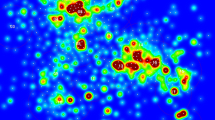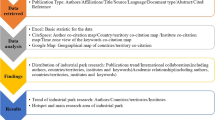Abstract
To reveal China’s regional disparity both in research output and preferential research areas is the main purpose of this study. For this study, we investigated the research outputs of all 31 regions (27 provinces and 4 municipalities) in mainland China. The investigated dataset was sourced from CNKI, one of China’s largest domestic academic databases. To measure research preferences between regions, we used the function of cosine distance rather than Euclidean distance. Clustering method was employed to classify the regions according to their similarity/disparity. In the end, six clusters were generated. Each cluster is different in research preferences. For example, Inner Mongolia in Cluster D is featured with the emphasis on animal handcraft; while Hubei province in Cluster A is characterized by a wide range of research areas.





Similar content being viewed by others
References
Andersson, D. E., Andersson, E., & Mellander, C. (2011). Handbook of creative cities. Cheltenham: Edward Elgar Publishing.
Andersson, D. E., Gunessee, S., & Matthiessen, C. W. (2014). The geography of Chinese science. Environment and Planning a, 46(12), 2950–2971.
Bornmann, L., Leydesdorff, L., Walch-Solimena, C., & Ettl, C. (2011). Mapping excellence in the geography of science: An approach based on Scopus data. Journal of Informetrics, 5(4), 537–546. doi:10.1016/j.joi.2011.05.005.
Gao, X., Guo, X., Sylvan, K. J., & Guan, J. (2010). The Chinese innovation system during economic transition: A scale-independent view. Journal of Informetrics, 4(4), 618–628. doi:10.1016/j.joi.2010.07.001.
Guan, J., & Gao, X. (2008). Comparison and evaluation of Chinese research performance in the field of bioinformatics. Scientometrics, 75(2), 357–379. doi:10.1007/s11192-007-1871-0.
Guan, J., & He, Y. (2005). Comparison and evaluation of domestic and international outputs in Information Science and Technology research of China. Scientometrics, 65(2), 215–244. doi:10.1007/s11192-005-0269-0.
Guan, J., & Ma, N. (2007a). A bibliometric study of China’s semiconductor literature compared with other major asian countries. Scientometrics, 70(1), 107–124. doi:10.1007/s11192-007-0107-7.
Guan, J., & Ma, N. (2007b). China’s emerging presence in nanoscience and nanotechnology: A comparative bibliometric study of several nanoscience “giants”. Research Policy, 36(6), 880–886. doi:10.1016/j.respol.2007.02.004.
Guan, J., & Wang, G. (2010). A comparative study of research performance in nanotechnology for China’s inventor-authors and their non-inventing peers. Scientometrics, 84(2), 331–343. doi:10.1007/s11192-009-0140-9.
Jain, A. K., Murty, M. N., & Flynn, P. J. (1999). Data clustering: a review. ACM Computing Surveys (CSUR), 31(3), 264–323.
Kostoff, R. (2008). Comparison of China/USA science and technology performance☆. Journal of Informetrics, 2(4), 354–363. doi:10.1016/j.joi.2008.06.004.
Leydesdorff, L., & Persson, O. (2009). Mapping the geography of science: Distribution patterns and networks of relations among cities. Journal of the American Society for Information Science and Technology, 61(8), 1622–1634. doi:10.1002/asi.
Moiwo, J. P., & Tao, F. (2012). The changing dynamics in citation index publication position China in a race with the USA for global leadership. Scientometrics, 95(3), 1031–1050. doi:10.1007/s11192-012-0846-y.
Sebag-Montefiore, C. (2012). Focus on China: A tale of two cities. Retrieved from http://www.sciencemag.org/careers/features/2012/09/focus-china-tale-two-cities.
Tian, P. (2015). Three giants tighten their grip. Nature, 528(7582), S176–S178. doi:10.1038/528S176a.
Van Eck, N. J., & Waltman, L. (2010). Software survey: VOSviewer, a computer program for bibliometric mapping. Scientometrics, 84(2), 523–538.
Wang, L. (2016). The structure and comparative advantages of China’s scientific research: Quantitative and qualitative perspectives. Scientometrics, 106(1), 435–452. doi:10.1007/s11192-015-1650-2.
Wang, G., & Guan, J. (2010). The role of patenting activity for scientific research: A study of academic inventors from China’s nanotechnology. Journal of Informetrics, 4(3), 338–350. doi:10.1016/j.joi.2010.02.002.
Xie, Y., Zhang, C., & Lai, Q. (2014). China’s rise as a major contributor to science and technology. Proceedings of the National Academy of Sciences, 111(26), 9437–9442.
Yang, S., Ma, F., Song, Y., & Qiu, J. (2010). A longitudinal analysis of citation distribution breadth for Chinese scholars. Scientometrics, 85(3), 755–765. doi:10.1007/s11192-010-0245-1.
Zhou, Y. (2015). The rapid rise of a research nation. Nature, 528(7582), S170–S173. doi:10.1038/528S170a.
Zhou, P., & Leydesdorff, L. (2006). The emergence of China as a leading nation in science. Research Policy, 35(1), 83–104.
Acknowledgements
This work was supported by the National Natural Science Foundation of China (Grant No. 71503031) and the China Postdoctoral Science Foundation (Grant No. 2016M591435). We gratefully acknowledge the review and inspired comments by an anonymous reviewer on an earlier version of the manuscript.
Author information
Authors and Affiliations
Corresponding author
Rights and permissions
About this article
Cite this article
Hu, Z., Guo, F. & Hou, H. Mapping research spotlights for different regions in China. Scientometrics 110, 779–790 (2017). https://doi.org/10.1007/s11192-016-2175-z
Received:
Published:
Issue Date:
DOI: https://doi.org/10.1007/s11192-016-2175-z




